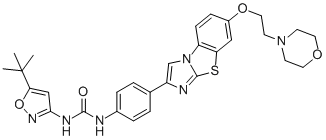All AbMole products are for research use only, cannot be used for human consumption.

Quizartinib (AC220) is a orally-administered, potent and selective inhibitor of two receptor tyrosine kinases, FLT3 and KIT. Quizartinib (AC220) exhibits low nanomolar potency in biochemical and cellular assays and exceptional kinase selectivity, and in animal models is efficacious at doses as low as 1 mg/kg given orally once daily. While other agents showed some ability to clear leukemia from the circulating blood, AC220 has shown significant ability to clear leukemic cells from the bone marrow, where the disease originates. AC220-resistant FLT3 kinase domain mutants represent high-value targets for future FLT3 inhibitor development efforts.

Patent. CN113549000A 2021 Oct 26.
Patent. CN113549000A
Quizartinib (AC220) purchased from AbMole

Drug Des Devel Ther. 2018 Apr 30;12:1009-1017.
Advances in the drug therapies of acute myeloid leukemia (except acute promyelocytic leukemia)
Quizartinib (AC220) purchased from AbMole
| Cell Experiment | |
|---|---|
| Cell lines | MV4-11 and RS4;11 cells |
| Preparation method | Cellular assays. MV4-11 and RS4;11 cells were cultured in Iscove media with 10% fetal bovine serum (FBS) and RPMI complete with 10% FBS, respectively. For proliferation assays, cells were cultured overnight in low serum media (0.5% FBS), then seeded in a 96-well plate at 40 000 cells per well. Inhibitors were added to the cells and incubated at 37°C for 72 hours. Cell viability was measured using the Cell Titer-Blue Cell Viability Assay from Promega. To measure inhibition of FLT3 autophosphorylation, cells were cultured in low serum media (0.5% FBS) overnight and seeded at a density of 400 000 cells per well in a 96-well plate the following day. The cells were incubated with inhibitors for 2 hours at 37°C. To induce FLT3 autophosphorylation in RS4;11 cells, 100 ng/mL FLT3 ligand was added for 15 minutes after the 2-hour compound incubation. Cell lysates were prepared and incubated in 96-well plates precoated with a total FLT3 capture antibody. The coated plates were incubated with either a biotinylated antibody against FLT3 to detect total FLT3 or an antibody against phosphotyrosines to detect FLT3 autophosphorylation. In both cases, a SULFO-tagged streptavidin secondary antibody was used for electrochemiluminescence detection on the Meso Scale Discovery platform. |
| Concentrations | 0~10 µM |
| Incubation time | 72 h |
| Animal Experiment | |
|---|---|
| Animal models | subcutaneous tumor model |
| Formulation | 22% hydroxypropyl-β-cyclodextrin |
| Dosages | 10 mg/kg |
| Administration | orally |
| Molecular Weight | 560.67 |
| Formula | C29H32N6O4S |
| CAS Number | 950769-58-1 |
| Solubility (25°C) | DMSO ≥100 mg/mL |
| Storage |
Powder -20°C 3 years ; 4°C 2 years In solvent -80°C 6 months ; -20°C 1 month |
| Related FLT3 Products |
|---|
| 4SC-203
4SC-203 is a potent multikinase inhibitor with potential antineoplastic activity. |
| AKN-028
AKN-028, a novel tyrosine kinase (TK) inhibitor, is a potent, orally active FMS-like receptor tyrosine kinase 3 (FLT3) inhibitor with an IC50 value of 6 nM. |
| FLT3-IN-3
FLT3-IN-3 is a potent FLT3 inhibitor with IC50s of 13 and 8 nM for FLT3 WT and FLT3 D835Y, respectively. |
| MAX-40279
MAX-40279 is a dual and potent inhibitor of FLT3 kinase and FGFR kinase. |
| FLT3-IN-10
FLT3-IN-10 is a potent inhibitor of FMS-like tyrosine kinase 3 (FLT3). |
All AbMole products are for research use only, cannot be used for human consumption or veterinary use. We do not provide products or services to individuals. Please comply with the intended use and do not use AbMole products for any other purpose.


Products are for research use only. Not for human use. We do not sell to patients.
© Copyright 2010-2024 AbMole BioScience. All Rights Reserved.
